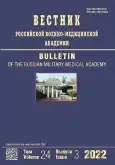A rare clinical case of household gas leak leading to severe asphixia
- Authors: Kryukov E.V.1, Gaiduk S.V.1, Goverdovskiy Y.B.1, Kuzmich V.G.1, Bogomolov A.B.1, Shapovalov I.D.1, Mihailov A.A.1, Lyanginen T.V.1, Vlasov S.S.1, Ivanov A.A.2
-
Affiliations:
- Military Medical Academy of S.M. Kirov
- Branch № 4 of the 419nd Military clinical hospital
- Issue: Vol 24, No 3 (2022)
- Pages: 521-528
- Section: Case report
- URL: https://journals.rcsi.science/1682-7392/article/view/107669
- DOI: https://doi.org/10.17816/brmma107669
- ID: 107669
Cite item
Abstract
A rare case of severe asphyxia in a young patient due to household gas leakage WAS presented. The patient was found in an unconscious state with signs of respiratory failure at home, requiring respiratory support at the prehospital stage. The patient had a picture of damage to the circulatory organs with the development of acute myocardial ischemia without damage and reactive hydropericardium, respiratory organs in the form of hypoxic pulmonary edema, complicated by the development of bilateral community-acquired pneumonia, hydrothorax and severe respiratory failure, damage to the nervous system with the development of hypoxic encephalopathy with loss of consciousness and bilateral pyramidal syndrome, digestive organs with the development of reactive posthypoxic hepatopathy. Upon admission to the clinic of the field therapy of the Military Medical Academy of S.M. Kirov, which required hospitalization of the patient in the intensive care unit. It was possible to fully stop severe multiple organ damage that developed as a result of acute hypoxic exposure as a result of the complex treatment. This clinical case clearly demonstrates the importance of emergency, systematic and full-fledged intensive care at all stages of providing care to people with acute hypoxic lesions of organs and systems, including severe community-acquired pneumonia and hypoxic myocardial dystrophy. The influence of the early intensive care initiation and timely evacuation at the stage of qualified and specialized medical care on the effectiveness of therapeutic measures is discussed as this plays a fundamental role in the survival of this category of patients. In general, with timely and full-fledged therapeutic measure implementation aimed at treating complications, even severe acute hypoxic organs lesions and systems are reversible, although this may require long-term inpatient treatment and rehabilitation measures in a military sanatorium-resort organization condition of a therapeutic profile, as well as conducting a military medical examination to establish the fitness category for further military service.
Full Text
##article.viewOnOriginalSite##About the authors
Evgeniy V. Kryukov
Military Medical Academy of S.M. Kirov
Email: evgeniy.md@mail.ru
ORCID iD: 0000-0002-8396-1936
SPIN-code: 3900-3441
Scopus Author ID: 57208311867
ResearcherId: AAO-9491-2020
Doctor of Medical Sciences, Professor
Russian Federation, Saint PetersburgSergey V. Gaiduk
Military Medical Academy of S.M. Kirov
Email: gaiduksergey@mail.ru
ORCID iD: 0000-0003-1524-9493
SPIN-code: 8602-4922
Doctor of Medical Sciences, Associate Professor
Russian Federation, Saint PetersburgYuriy B. Goverdovskiy
Military Medical Academy of S.M. Kirov
Email: goverdoc@yandex.ru
ORCID iD: 0000-0003-1241-9725
SPIN-code: 2605-7097
Doctor of Medical Sciences
Russian Federation, Saint PetersburgVladimir G. Kuzmich
Military Medical Academy of S.M. Kirov
Email: q-zmich1978@mail.ru
ORCID iD: 0000-0001-7754-3634
SPIN-code: 7135-6357
Candidate of Medical Sciences
Russian Federation, Saint PetersburgAlexey B. Bogomolov
Military Medical Academy of S.M. Kirov
Email: Bg-ab@mail.ru
ORCID iD: 0000-0002-6110-1097
SPIN-code: 4175-2774
Candidate of Medical Sciences
Russian Federation, Saint PetersburgIlya D. Shapovalov
Military Medical Academy of S.M. Kirov
Author for correspondence.
Email: ilshapovalov@yandex.ru
ORCID iD: 0000-0001-7986-3359
SPIN-code: 9775-9491
Adjunct
Russian Federation, Saint PetersburgAlexey A. Mihailov
Military Medical Academy of S.M. Kirov
Email: auri8@mail.ru
ORCID iD: 0000-0001-5656-2764
SPIN-code: 3957-6107
Adjunct
Russian Federation, Saint PetersburgTimofey V. Lyanginen
Military Medical Academy of S.M. Kirov
Email: finn_off@mail.ru
ORCID iD: 0000-0003-3816-9242
SPIN-code: 3494-6532
Candidate of Medical Sciences
Russian Federation, Saint PetersburgStanislav S. Vlasov
Military Medical Academy of S.M. Kirov
Email: vlasovstass@mail.ru
ORCID iD: 0000-0003-3407-1096
Candidate of Medical Sciences
Russian Federation, Saint PetersburgArtem A. Ivanov
Branch № 4 of the 419nd Military clinical hospital
Email: rusfanstar@mail.ru
ORCID iD: 0000-0003-1009-6096
Resident
Russian Federation, AnapaReferences
- Zhuravlev AA, Piskulov NS, Kirichenko EP, Krupina NA. Otravleniya komponentami bytovogo gaza. Russian Journal of Forensic Medicine. 2016;2(2):84. (In Russ.).
- Litvitskii PF. Klinicheskaya patofiziologiya. Moscow: Prakticheskaya meditsina, 2017. 776 p. (In Russ.).
- Yankovsky VE, Shadymov AB, Kazymov MA, Yurchenko AY. Death by inhalation of city gas - is it poisoning or...? Vestnik sudebnoi meditsiny. 2014;3(2):39–41. (In Russ.).
- Kalinina EYu. Characteristics of forensic medical diagnosis of poisoning by household gas in living persons. Modern Problems of Science and Education. Surgery. 2015;(6):248. (In Russ.).
- Evseeva MA, Evseev AV, Pravdivtsev VA, Shabanov PD. Mekhanizmy razvitiya ostroi gipoksii i puti ee farmakologicheskoi korrektsii. Reviews on Clinical Pharmacology and Drug Therapy. 2008;6(1):3–25. (In Russ.).
- Livanov GA, Aleksandrov MV, Batotsyrenov BV, et al. Methods for the prevention and treatment of toxico-gipocical encephalopathy in patients with acute severe poisoning. Clinical Medicine (Russian Journal). 2011;89(6):56–59. (In Russ.).
Supplementary files















